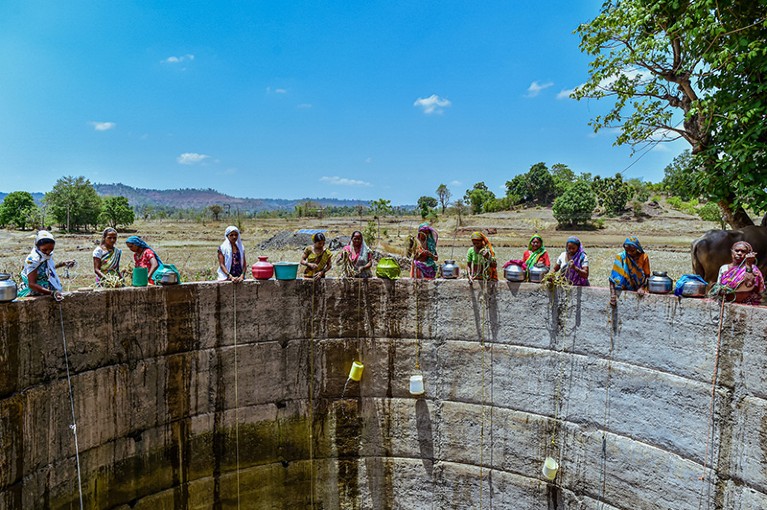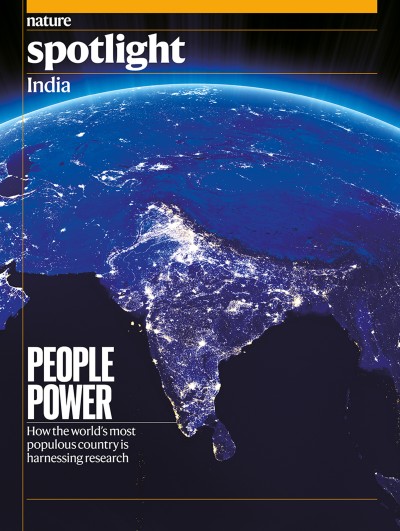
Floods similar to this one at Gurugram in August are becoming more common in India.Credit: Parveen Kumar/Hindustan Times via Getty
India is facing a harsh new reality. In Kerala, near the southern tip of the subcontinent, floods frequently inundate farmlands and pour into households. In the sea off Mumbai, fewer fish are caught owing to an increase in cyclones and heavier rainfall. Farther north in Rajasthan, cattle farmers face rising temperatures and water shortages. In the northern state of Uttarakhand, forest fires are more frequent today than in the past. And in Satabhaya, a coastal village off the Bay of Bengal, rising sea levels and coastal erosion have forced hundreds of families to leave. All these problems have, of course, been exacerbated by climate change.
Since the pre-industrial period, India’s rising temperature has caused the Himalayan glaciers to retreat, droughts to worsen, flash floods and landslides to increase and cyclones to intensify across the country’s 7,500-kilometre-long coastline. These events are now occurring on a regular basis (see ‘India’s extreme weather events’). In the first nine months of 2022, for example, India had an extreme weather event nearly every single day. “It can be a year-long swaying of the climate sledgehammer,” says Raghu Murtugudde, a climate researcher at the Indian Institute of Technology Bombay. “We now have disasters in pretty much every season.”

Source: Centre for Science and Environment
Worrying change
In 2020, India’s Ministry of Earth Sciences published the first climate-change assessment report for the country1. It was based on data from 1901 to 2018 and showed that the country’s average temperature in that period had risen by roughly 0.7 °C, bringing with it extreme weather patterns.
March 2022, for example, was the hottest March on the subcontinent since records began in 1901, with temperatures of more than 40 °C combined with a drought as rainfall slowed to about one-third of normal rates. The two placed enormous stress on agriculture, with some regions experiencing a 30% reduction in their harvests, forcing the country to restrict its wheat exports. The increased demand on the electricity grid, partly caused by the increased use of air-conditioning units, caused the worst electricity shortage in more than six years. At least two states, Tripura in the northeast and West Bengal in the east, ordered schools to close. The extreme temperatures led to the deaths of at least 90 people. “It really shocked the country,” says Chandni Singh, who works on climate-change adaptation at the Indian Institute for Human Settlements, a national education institution based in Bengaluru.
Heatwaves often have cascading effects on other hazards, leading to wildfires that destroy crops and release dangerous smoke, as well as accelerating the spread of infectious diseases and causing death. They can also lead to water shortages. Warmer air can hold more moisture, leading to lengthy dry periods before all that moisture gets dumped in a matter of days or even hours.
The 2020 assessment1 shows that the total seasonal rainfall had dropped, but when it does rain, it pours, causing floods and landslides. In July this year, for example, torrential rain tore across northern India, causing landslides and flash floods, killing at least 22 people. And in August, heavy monsoon rains triggered landslides in India’s Himalayan region, leaving nearly 50 people dead.
Events such as these have become the new normal. A climate assessment report published in November 2022 by the Centre for Science and Environment, a public-interest research and advocacy organization based in New Delhi, analysed the first nine months of 2022. It found that India experienced extreme weather events, ranging from heatwaves to cyclones, for 88% of that time period2. These disasters claimed 2,755 lives, affected 1.8 million hectares of crops, destroyed around 400,000 homes and killed almost 70,000 livestock.
“This is the watermark of climate change,” the report states2. “It is not about the single event but about the increased frequency of the events — an extreme event we saw once every 100 years has now begun to occur every five years or less. Worse, it is now all coming together — each month is breaking a new record. This in turn is breaking the backs of the poorest who are worst impacted and are fast losing their capacities to cope with these repeated and frequent events.”
Vulnerability
Part of the problem is that India is positioned between the melting Himalayas and three rapidly warming bodies of water. The Arabian Sea warmed by 2 °C from 1982 to 2019, pumping moisture into northwest India. But the mountains squeeze the moisture from these damp winds as if they were a sponge, dumping rain and causing floods and landslides. The temperature of the sea now hovers at around 28 °C, which is warm enough for cyclones to form. A 2021 study shows that there has been a 50% increase in the number of cyclones in the past 40 years from the Arabian Sea3.
There is “one extreme weather event after another — whether it’s the monsoon or the tropical cyclones”, says Roxy Mathew Koll, an oceanographer at the Indian Institute of Tropical Meteorology in Pune.
To make matters worse, those cyclones now intensify rapidly, strengthening to dangerous storms in a matter of hours. Cyclone Amphan, for example, which caused widespread damage in eastern India in May 2020, initially had wind speeds of 140 kilometres per hour but quickly strengthened to 215 kilometres per hour, switching from a category 1 cyclone to a category 4 cyclone in less than a day. “We go to sleep thinking that it’s a big cyclone and by the time we wake up, our roofs are gone,” Koll says. “There is no time to respond.”

Women in Maharashtra state draw water from a well that is almost empty.Credit: Ritesh Shukla/Getty
It is clear that India’s unique locale places it at the mercy of climate change, but Singh points out that it is societal and economic factors that leave the Indian population with little protection. For example, in a heatwave, someone who can remain indoors with a cooling system is much less exposed than is a street vendor who needs to work outside — but fewer than 10% of Indians own air-conditioning. Furthermore, India’s booming population will place further demand on food and water, and the sheer number of people living in vulnerable areas (particularly in coastal regions) will rise, meaning climate change will take an even greater toll.
Mumbai is particularly vulnerable, Koll says. It is already one of the most populous cities in the world and its population is likely to double to around 40 million by 2050. By that time, climate projections suggest a global temperature increase of 2 °C, causing worse monsoons, cyclones, storm surges, heatwaves and increased humidity in the city. “The impact at that time is unimaginable, even for climate scientists like me,” he says.
Managing the fallout
The 2020 assessment1 projected that the average temperature in India will increase by 4.4 °C by the end of the century. That will cause summer heatwaves to be 3–4 times more common and twice as long. A study by the Climate Impact Lab at the Tata Centre for Development, University of Chicago, predicts that there will be one million deaths a year from extreme heat in India by the end of the century if greenhouse emissions continue at their current level4.
This means India needs to adapt to climate change. “We are headed to a very, very warm and hot world,” says Karthik Ganesan, a fellow at the Council on Energy, Environment and Water, a non-profit policy-research institution in New Delhi. “India’s effort must go towards figuring out solutions and managing the fallout of climate change.”
In 2008, the Indian government launched the National Action Plan for Climate Change in an effort to do just that. The country has since poured money into hundreds of different adaptation schemes, from more-efficient irrigation systems to early-warning systems. The latter are crucial. If the government knows a cyclone is coming, for example, it can arrange an evacuation that can save lives. Before a drought, farmers can plan their irrigation effectively. And hospitals will have time to prepare for an influx of patients before a heatwave.
Some of these adaptation schemes have already made an impact. In 2013, Ahmedabad, a city north of Mumbai in western India, implemented the first heat action plan across India and south Asia. After a six-day heatwave in 2010 that reached 46.8 °C and caused an extra 1,344 deaths (a 43.1% jump above the baseline death rate), the plan’s main goal was to alert the populations most at risk. But it also alerted government agencies, health officials, emergency responders, local community groups and media outlets. And it provided training to health-care professionals to help them prevent and manage heat-related cases. A later study estimated that 2,380 deaths were avoided in the two years after the plan was put into action5. Today, 30 similar plans are in place across the country.
Heat action plans are not the only success story. In 1999, the Odisha cyclone, which hit the east coast south of Kolkata, peaked with winds of 260 kilometres per hour and killed nearly 10,000 people (although some estimates suggest there were as many as 30,000 fatalities). With the help of improved forecasts today, cyclones of similar intensity kill dozens of people, not thousands, Koll says.
The study that analysed the first nine months of 2022 also found that fatalities from cyclones are increasingly rare2. Cyclones that devastated nearly 100,000 hectares of land resulted in only two deaths. “This is because of the laudable work” done by the India Meteorological Department in cyclone forecasting, so “there is adequate warning to governments”, the report states.
Despite these advancements, Singh argues that many of the adaptation schemes are insufficient, mainly because the country is so large with so many different hazards. It also struggles to think holistically about many of these issues, she says. For example, Indian farmers have started using drought-resilient seed, but the government has not reformed the agrarian system as a whole. This means that farmers will simply run into other problems down the line, such as a lack of refrigerated trucks to ensure that the produce reaches the consumer in a decent condition.
Singh says more fundamental change is needed. “We cannot be thinking of endlessly adapting to heatwaves or endlessly raising houses on stilts. We need to make deep changes in how we run the world.”
India has invested in solar and wind power. It has committed to the Paris agreement to reduce its carbon intensity. And it has increased forest regeneration. These steps should help to mitigate the worst effects of climate change, although it needs other countries to take similar steps as well. As Singh says: “This is just a horrific trailer of what’s to come.”


 India’s year in science
India’s year in science
 Where science meets Indian economics: in five charts
Where science meets Indian economics: in five charts
 Renewable energy for the subcontinent
Renewable energy for the subcontinent
 We need to talk about water
We need to talk about water
 I predict solar storms
I predict solar storms
 The fight against antimicrobial resistance
The fight against antimicrobial resistance
 How high-impact papers from Indian researchers are shaping science
How high-impact papers from Indian researchers are shaping science
 India struggles to turn science into societal benefits
India struggles to turn science into societal benefits
 Big ideas: India’s drive to stem the brain drain
Big ideas: India’s drive to stem the brain drain
 I study depression in the lab and advocate for mental health in academia
I study depression in the lab and advocate for mental health in academia






